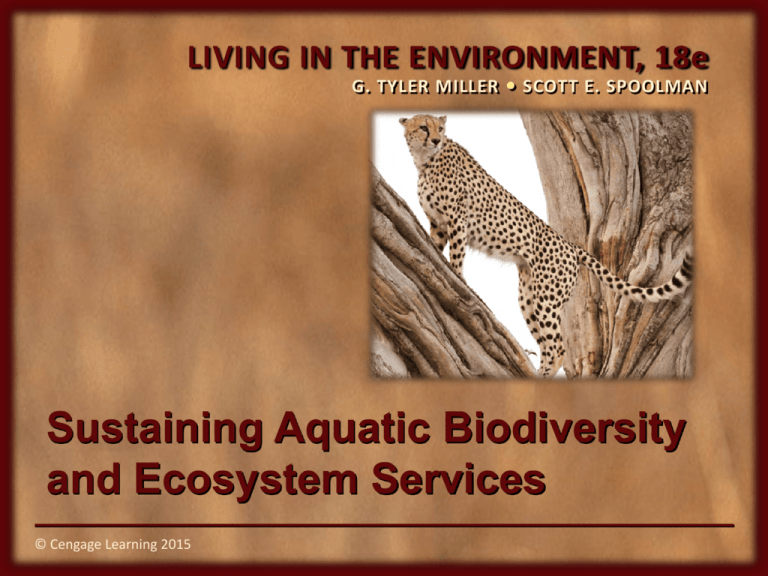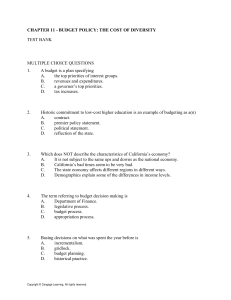Sustaining Aquatic Biodiversity and Ecosystem
advertisement

LIVING IN THE ENVIRONMENT, 18e G. TYLER MILLER • SCOTT E. SPOOLMAN Sustaining Aquatic Biodiversity and Ecosystem Services ©©Cengage CengageLearning Learning2015 2015 Case Study: The Plight of Sea Turtles • All seven species in danger through: – Trawler fishing • Destroyed many coral gardens that are turtle feeding grounds – Turtles hunted for leather – Eggs taken for food – Pollution of ocean water © Cengage Learning 2015 What Are the Major Threats to Aquatic Biodiversity and Ecosystem Services? • Aquatic species and the ecosystem and economic services they provide are threatened by: – Habitat loss, invasive species, pollution, climate change, and overexploitation – All made worse by the growth of the human population and resource use © Cengage Learning 2015 We Have Much to Learn about Aquatic Biodiversity • We have explored about 5% of the oceans • Greatest marine biodiversity – Coral reefs, estuaries, and deep-ocean floor • Biodiversity is higher – Near the coast than in the open sea – In the bottom region of the ocean than the surface region © Cengage Learning 2015 Human Activities Are Destroying and Degrading Aquatic Habitat • Marine – Coral reefs – Mangrove forests – Seagrass beds – Ocean acidification • Freshwater – Dams © Cengage Learning 2015 Invasive Species Are Degrading Aquatic Biodiversity • Invasive species – Threaten native species – Disrupt and degrade whole ecosystems – Blamed for about twothirds of all fish extinctions since 1900 • Example – Lionfish in the Atlantic © Cengage Learning 2015 Population Growth and Pollution Can Reduce Aquatic Biodiversity • 80% of all humans living along coasts • Nitrates and phosphates, mainly from fertilizers, enter water – Leads to eutrophication • Toxic pollutants from industrial and urban areas • Plastics – Ocean garbage © Cengage Learning 2015 Climate Change Is a Growing Threat • Sea levels will rise and aquatic biodiversity is threatened – Coral reefs – Swamp some low-lying islands – Drown many highly productive coastal wetlands – Warmer ocean water stresses phytoplankton © Cengage Learning 2015 Overfishing and Extinction: Gone Fishing, Fish Gone • Fishery – concentration of a particular wild aquatic species suitable for commercial harvesting in a specific area • Fishing key factor in the depletion of up to 80% of the population of some wild fish species in only 10-15 years • Trawlers – Destroy ocean bottom habitat © Cengage Learning 2015 Overfishing and Extinction: Gone Fishing, Fish Gone • Purse-seine fishing – Can kill dolphins • Long-lining – Kills large numbers of sea turtles, dolphins, and seabirds • Drift net fishing – Large bycatch © Cengage Learning 2015 Overfishing and Extinction: Gone Fishing, Fish Gone • Fishprint – area of ocean needed to sustain the fish consumption of an average person, nation, or the world • Overfishing leads to commercial extinction – Commercially valuable fish become scarce – Bluefin tuna ranching • Some marine mammals are also threatened due to overfishing © Cengage Learning 2015 Case Study: The Great Jellyfish Invasion • Most jellyfish feed on zooplankton, fish eggs, small fish, and other jellyfish • Often found in blooms of thousands of individuals – Numbers of blooms rising in recent years • Overfishing of species that prey on jellyfish • Excessive nutrients in land runoff © Cengage Learning 2015 • Warmer waters Case Study: Why Should We Protect Sharks? • Sharks are keystone species – If they become extinct, their ecosystems will suffer • For every shark that injures a person, people kill about 1.2 million sharks – 32% of open-ocean shark species are threatened with extinction © Cengage Learning 2015 Extinction of Aquatic Species Is a Growing Threat • Biological extinction – Overfishing, water pollution, wetlands destruction, excessive removal of water from lakes and rivers – 34% of marine species are threatened – 71% of freshwater species are threatened © Cengage Learning 2015 How Can We Protect and Sustain Marine Biodiversity? • We can help to sustain marine biodiversity by: – Using laws and economic incentives to protect species – Setting aside marine reserves to protect ecosystems and ecosystem services – Using community-based integrated coastal management © Cengage Learning 2015 Laws, Treaties, and Economic Incentives Can Help Sustain Aquatic Biodiversity • Human ecological footprint and fishprint are expanding • Much of the damage in the ocean is not visible • The oceans are incorrectly viewed as an inexhaustible resource • Most of the ocean lies outside the legal jurisdiction of any country © Cengage Learning 2015 Laws, Treaties, and Economic Incentives • Some examples: – 1975 Convention on International Trade in Endangered Species (CITES) – 1979 Global Treaty on Migratory Species – U.S. Endangered Species Act of 1973 – U.S. Whale Conservation and Protection Act of 1976 – 1995 International Convention on Biological Diversity © Cengage Learning 2015 Marine Sanctuaries Protect Ecosystems and Species • Offshore fishing – Exclusive economic zones for countries • 200 nautical miles – High seas governed by treaties that are hard to enforce • Law of the Sea Treaty – Misused • Marine protected areas (MPAs) – Protected from human activities © Cengage Learning 2015 Establishing a Global Network of Marine Reserves: An Ecosystem Approach • Marine reserves – Closed to: • Commercial fishing • Dredging • Mining and waste disposal – Core zone • No human activity allowed – Less harmful activities allowed • Example: recreational boating and shipping © Cengage Learning 2015 Establishing a Global Network of Marine Reserves • Fully protected marine reserves work fast – Fish populations double – Fish size grows – Reproduction triples – Species diversity increase by almost onefourth • Cover less than 1% of world’s oceans – Marine scientists want 30-50% © Cengage Learning 2015 Restoration Helps to Protect Marine Biodiversity but Prevention Is the Key • Japan’s attempt – Seeding reef with new corals • Problems that cause degradation need to be addressed • Integrated coastal management – Community-based sustainability movement © Cengage Learning 2015 How Should We Manage and Sustain Marine Fisheries? • Sustaining marine fisheries will require: – Improved monitoring of fish and shellfish populations – Cooperative fisheries management among communities and nations – Reduction of fishing subsidies – Careful consumer choices in buying seafood © Cengage Learning 2015 Estimating and Monitoring Fishery Populations Is the First Step • Maximum sustained yield (MSY) – Traditional approach – Projects maximum annual harvest without causing population drop • Optimum sustained yield (OSY) – Attempts to account for interactions among species • Multispecies management © Cengage Learning 2015 Estimating and Monitoring Fishery Populations Is the First Step • Large marine systems – Using large complex computer models • Precautionary principle – Sharply reducing fish harvests – Closing overfished areas © Cengage Learning 2015 Some Communities Cooperate to Regulate Fish Harvests • Community management of the fisheries • Co-management of the fisheries with the government – Government sets quotas for species and divides the quotas among communities – Limits fishing seasons – Regulates fishing gear © Cengage Learning 2015 Government Subsidies Can Encourage Overfishing • Governments spend over 30 billion dollars per year subsidizing fishing – Often leads to overfishing – Discourages long-term sustainability of fish populations © Cengage Learning 2015 Consumer Choices Can Help to Sustain Fisheries and Aquatic Biodiversity • Need labels to inform consumers how and where fish was caught • 1999 – Marine Stewardship Council (MSC) – Certifies sustainably produced seafood • What is the proper use of sustainable aquaculture? © Cengage Learning 2015 Coastal and Inland Wetlands Are Disappearing around the World • Wetlands have been disturbed for centuries • Sea level rise – Will inundate coastal wetlands © Cengage Learning 2015 We Can Preserve and Restore Wetlands • Laws for protection – Zoning laws steer development away from wetlands – In U.S., a federal permit is required to fill wetlands greater than three acres • Mitigation banking – Can destroy wetland if one is created of equal area – Ecologists argue that this as a last resort © Cengage Learning 2015 Case Study: Can We Restore the Florida Everglades? • Damage in the 20th century – Drained – Diverted – Paved over – Nutrient pollution from agriculture – Invasive plant species • 1947 – Everglades National Park was an unsuccessful protection project © Cengage Learning 2015 Case Study: Can We Restore the Florida Everglades? • 1990 – Comprehensive Everglades Restoration Plan (CERP) – Restore curving flow of ½ of Kissimmee River – Remove canals/levees in strategic locations – Flood farmland to create artificial marshes – Create 18 reservoirs to create water supply for lower Everglades and humans – Recapture Everglades water flowing to sea and return it to Everglades • Already weakened by Florida legislature © Cengage Learning 2015 Freshwater Ecosystems Are in Jeopardy • • • • • 40% of world’s rivers are dammed Many freshwater wetlands destroyed Invasive species Overfishing Human population pressures © Cengage Learning 2015 Case Study: Can the Great Lakes Survive Repeated Invasions by Alien Species? • Collectively, world’s largest body of freshwater • Invaded by at least 162 nonnative species – Sea lamprey – Zebra mussel – Quagga mussel – Asian carp © Cengage Learning 2015 Managing River Basins Is Complex and Controversial • Columbia River – U.S. and Canada – 119 dams • Dams – Provide hydroelectric power – Provide irrigation water – Hurt salmon © Cengage Learning 2015 We Can Protect Freshwater Ecosystems By Protecting Watersheds • Freshwater ecosystems protected through: – Laws – Economic incentives – Restoration efforts • Wild rivers and scenic rivers – 1968 National Wild and Scenic Rivers Act © Cengage Learning 2015 Freshwater Fisheries Need Better Protection • Sustainable management – Support populations of commercial and sport fish species – Prevent overfishing – Reduce or eliminate invasive species © Cengage Learning 2015




